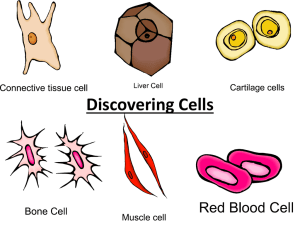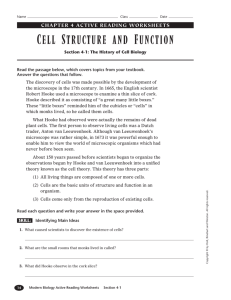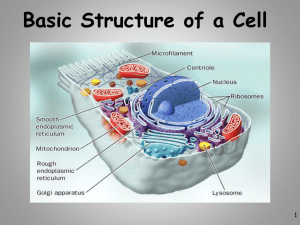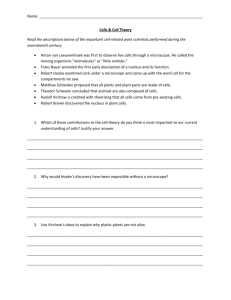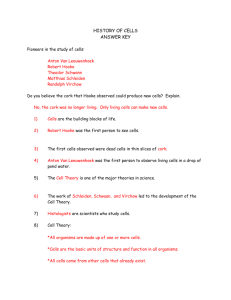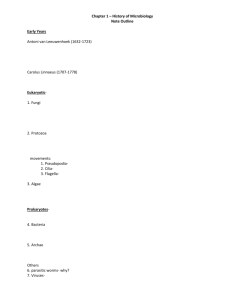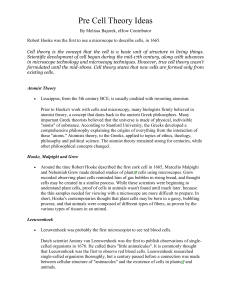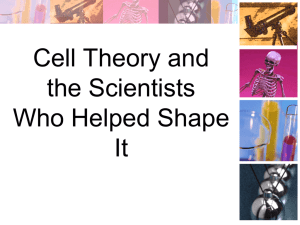1-History
advertisement
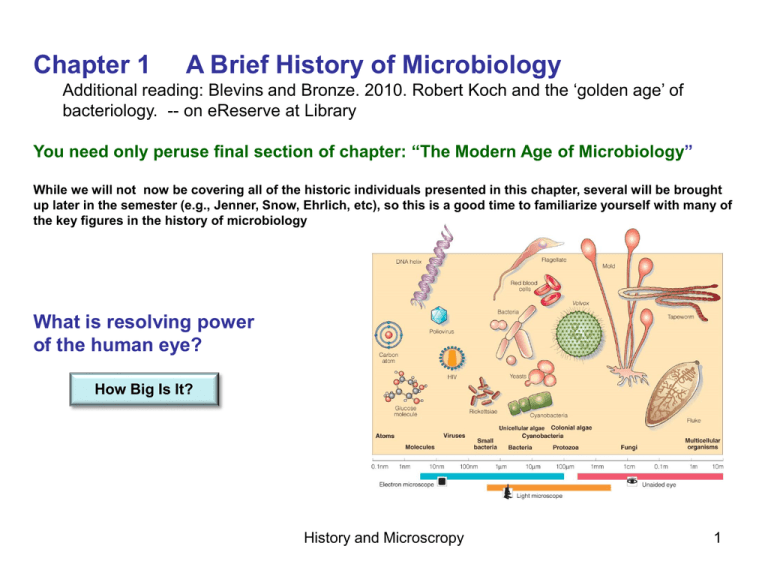
Chapter 1 A Brief History of Microbiology Additional reading: Blevins and Bronze. 2010. Robert Koch and the ‘golden age’ of bacteriology. -- on eReserve at Library You need only peruse final section of chapter: “The Modern Age of Microbiology” While we will not now be covering all of the historic individuals presented in this chapter, several will be brought up later in the semester (e.g., Jenner, Snow, Ehrlich, etc), so this is a good time to familiarize yourself with many of the key figures in the history of microbiology What is resolving power of the human eye? How Big Is It? History and Microscropy 1 When were microbes first discovered? Antoni van Leeuwenhoek The greatest lens maker of all time? Reported seeing microbes late 17th century (1680s) Used a “simple microscope” aka “flea lens” Observed all sorts of things… cause of taste and protozoa History and Microscropy 2 Van Leeuwenhoek’s discovery of bacteria “ van Leeuwenhoek was proud of his clean teeth and described his regimen for keeping them in that condition in his letter of 17 September 1683. Each morning he rubbed his teeth, using salt as an abrasive, and then rinsed his mouth with water. After eating he picked his teeth with a toothpick and then rubbed them well with a piece of cloth. He was well satisfied with his regimen and commented that few people of his age had such clean and white teeth. He was then just 5 weeks short of his 51st birthday. Despite his thorough regimen, on examining his teeth with a magnifying mirror he found that they were not as clean as he thought: "Yet by doing so my teeth are not clean, for when I look at them with a magnifying mirror there remains or grows between some of the molars and teeth a little white matter, about as thick as batter. ... Although the consistency of the batter-Iike matter prevented good microscopic observations, van Leeuwenhoek's suspicion was aroused as to the possibility that living organisms were present in the white matter. He then mixed some white matter with clean rainwater, after determining that the water was free of little animals. ....Microscopic examination revealed that the preparations contained "many very small living animals, which moved very prettily" On this occasion van Leeuwenhoek made drawings of the organisms, which are now reproduced in virtually all introductory microbiology books and also in many higher-level books.” from Bardell, D. (1982) The role of the sense of taste and clean teeth in the discovery of bacteria by Antoni van Leeuwenhoek. Microbiological Reviews 47:121-126. History and Microscropy 3 What were Robert Hooke’s Contributions to Science? 1635-1703 Physics, Mechanics Meteorology Biology Microscopy Hooke’s microscope The Micrographia Bookworm http://www.gutenberg.org/ebooks/15491 History and Microscropy 4 Hooke wrote that cork consists of … “solid or hardened froth, or a congeries of very small bubbles consolidated in that form, into a pretty stiff as well as tough concrete, and that each Cavern, Bubble, or Cell, is definitely separate from any of the rest, without any kind of hole in the encompassing films…” He wondered about nutrient transport in plants… “But though I could not with my Microscope, nor with my breath, nor any other way I have yet tried, discover a passage out of one of those cavities into another, yet I cannot thence conclude, that therefore there are none such, by which the Succus nutritius, or appropriate juices of Vegetables, may pass through them; for, in several of those Vegetables, whilst green, I have with my Microscope, plainly enough discovered these Cells or Poles filled with juices… Now, though I have with great diligence endeavoured to find whether there be any such thing in those Microscopical pores of Wood or Piths, as the valves in the heart, veins, and other passages of Animals, that open and give passage to the contained fluid juices one way, and shut themselves, and impede the passage of such liquors back again, yet have I not hitherto been able to say anything positive in it; though, me thinks, it seems very probable, that Nature has in these passages, as well as in those of Animal bodies, very many appropriated Instruments and contrivances, whereby to bring her designs and end to pass, which 'tis not improbable, but that some diligent observer, if helped with better Microscopes, may in time detect.” History and Microscropy 5 Pasteur’s contributions were many: -- yeasts and fermentation -- ‘Pasteurization’ -- germ theory of disease -- immunology Resolved debate over ‘spontaneous generation’ of microorgansisms History and Microscropy 6 Some classic experiments in the debate over spontaneous generation History and Microscropy 7 Early Microbiologists advanced the Germ Theory of disease -- radically altered society Notion not readily accepted: religious beliefs; contrary to perceptions From Nancy Tomes (1998) The Gospel of Germs Harvard Univ Press, Cambridge, MA pp 34-35 “It is not surprising that idea of microbes causing disease was difficult to accept. Objections came not just from poorly educated or marginal physicians, but also from some of the most intelligent, systematic thinkers of the period. Many physicians committed to making medicine more scientific were deeply suspicious of overly simplistic theories of any sort, which they felt harkened back to the sterile hypothesizing of eighteenth-century medicine. Reducing the whole complex origin of an epidemic to the agency of a microbe struck them as a step backward, not forward, in medical thinking. Others objected to the premises of experimentalism itself. To their way of thinking, the behavior of test tube cultures or experimental animals bore no useful analogy to human disease; close observation of many cases of illness provided a much more authoritative body of evidence about the nature of illness. Still others objected not to the validity of laboratory evidence, but rather to its interpretation. ... The very ubiquity claimed for the germ made it difficult for physicians to accept its causal role in disease. Microscopists routinely found many microbial forms on the body and in the secretions of healthy people, so it seemed obvious that the presence of germs alone did not cause illness. As Massachusetts physician Edward P. Hurd remarked in an 1874 review of the evidence for the germ theory, "All the higher organisms seem to be indifferent to them," at least so long as they remained in good overall health. Moreover, skeptics argued, the growth of unusual bacteria in the secretions of the sick could be the consequence rather than the cause of their illness.” History and Microscropy 8 Robert Koch: second only to Pasteur? Lab made numerous discoveries -- and new methodologies The Petri plate (R.J. Petri) Solid media -- Potato slices -- Agar as solidifying agent -- better than gelatin Advances in Sterile technique Pure cultures from colony formation Photomicroscopy History and Microscropy 9 Koch’s Postulates: 1881 -- in Chapter 14 Bacillus anthracis causes anthrax 1. Show that the suspected agent is present in all cases of the disease; i.e., there are no exceptions. 2. Isolate the agent and grow as a pure culture. 3. Show that the same disease develops when the pure culture is inoculated into a healthy animal. What are some limitations to Koch’s Postulates? 4. Re-isolate the pathogen from the inoculated animal and show that it is the same organism. Serious human pathogens Viruses “Causative associations” History and Microscropy 10 Bacillus Anthracis and Anthrax (in Chapters 19 & 22) The Pathogen – a bacterium habitat The Disease of animals & humans modes of exposure -- cutaneous -- gastrointestinal -- pulmonary Bioterrorism potential Wikipedia link http://en.wikipedia.org/wiki/Anthrax Eschar lesion History and Microscropy 11
